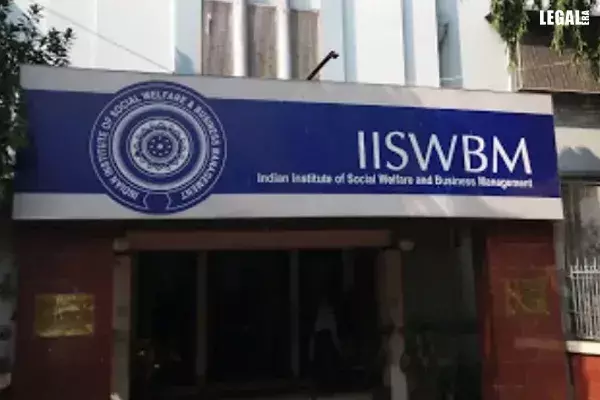Calcutta High Court: Clauses included MOA which are Considered to be the ‘Basic Structure’ Cannot be Altered or Amended
The Calcutta High Court while setting aside the decision taken in a meeting of the Board of Governors (BOG) of the Indian;

Calcutta High Court: Clauses included MOA which are Considered to be the ‘Basic Structure’ Cannot be Altered or Amended
The Calcutta High Court while setting aside the decision taken in a meeting of the Board of Governors (BOG) of the Indian Institute of Social Welfare and Business Management observed that, provisions contained in the Memorandum of Association which are cardinal features could be very well be termed as the ‘Basic Structures and the same cannot be denuded.
The single judge Justice Sabyasachi Bhattacharyya stated that in the scheme of things and in order to maintain proper checks and balances, the existence of the Board of Trustees (BOT) was undoubtedly an essential feature of the Institute and its Memorandum of Association (Memorandum).
In the present case, a decision was taken in a meeting of the Board of Governors (BOG) of the Indian Institute of Social Welfare and Business Management (IISWBM) whereby the President had opined that the Board of Trustees (BOT) would be dissolved and the BOG would continue. The said proposal was accepted by the BOG and confirmed subsequently in a meeting dated 10 December, 2018.
The petitioner argued that the said resolution was patently contradictory to the Memorandum of Association of the Institute and, if accepted, would render the functioning of the Institute lop-sided by concentrating the entire power in the BOG, which was never the intention of the founders.
The judge upon perusal of the relevant clauses including Clauses 38, 39, 42 and 44, of the Memorandum of Association of the Institute, held that it undoubtedly indicated that the BOT had an essential role to play within the scheme.
The bench rejected the arguments forwarded by the Respondent no. 1- The Director And Member Secretary Board Of Governors (IISWBM) that the amendments or alterations to the Memorandum or Rules and Regulations of the Institute had to be mandatorily placed before the AGM did not find place in the provisions of the Memorandum itself.
The Court rather, stated that Clause 57 indicated that two-thirds of the members of the BOG could, by voting at their own meeting after notice of the proposed amendment of not less than one month and such amendment or alteration which would have taken effect would be binding on all of its existing members.
The Court was of the considered view that the argument made by respondent no. 1 terming the petition was premature, could not be accepted.
The Court observed, “As per the statutory requirement, the resolution merely has to be intimated to the appropriate authority for the purpose of giving the same the sanctity of law. However, there is nothing to prevent the said decision to be implemented even now, as there is no specific time-bar for the same. Thus, the apprehension of the petitioner is quite valid to the extent that the impugned decision, if permitted to remain, may be implemented at any point of time.”
Even without going into the merits of the allegation that the challenge could not be taken out before the removal of respondent no. 2 from his office as the Minister of Higher Education, Government of West Bengal, the Court remarked, that the cause of action on the basis of apprehension of the petitioner was still alive and was a continuing cause of action, since the impugned decision could be implemented by the BOG at any point of time at its option.
Therefore, the Court concluded that the BOG could not arrogate to itself the entire trove of powers in respect of the Institute, in the teeth of Clauses 38, 39, 42 and 44, which were cardinal features of the Memorandum of Associations of the Institute.
The Court reckoned, “The said provisions could very well be termed as the ‘basic structure’ of the Memorandum of Association and contained the implicit balancing factors contemplated in the functioning of the Institute, of which the memorandum could not be denuded. Such an amendment, if permitted, would demolish the very concept of functioning of the Institute and its autonomy, all the more so since several members of the BOG were functionaries of the State, who were ex-officio members of the BOG. Hence it was stated that the defense of delay taken by the respondents could not be paid heed to.”
Thus, the judge held that although BOG had primacy in certain aspects, it was not the be-all and end- all of the Institute and could not be rendered so by effecting an amendment at the own sweet will of the governors.
Lastly, with respect to the locus standi of the petitioner, the Court recognized that he was a part of the meeting confirming the impugned decision and was the sole objector to the impugned amendment.
The Court affirmed that, “The very fact of the petitioner being recognized as a part of the said meeting indicates that he had the locus standi to be a part of the meeting, prima facie as a member of the BOT. If the respondents were to challenge his membership of the BOT, it was for the respondents to plead and prove the same in accordance with law, which, having not been done, it does not lie in the mouth of the respondents to deny the locus standi of the petitioner, even as an integral part of the functioning of the Institute, to prefer a challenge to the paradigm alteration of the Memorandum of Association of the Institute.”
Accordingly, the High Court set aside the impugned decision of the BOG of the Institute taken on 30 May, 2017 including its subsequent confirmations.

